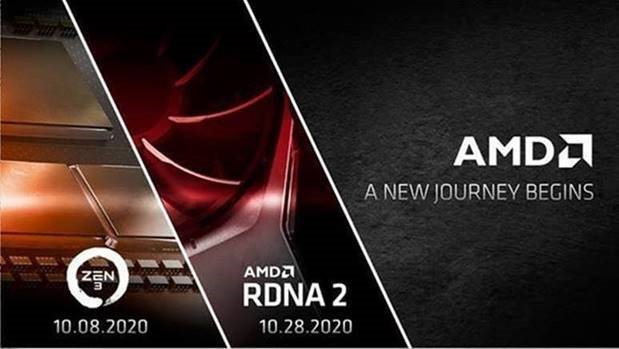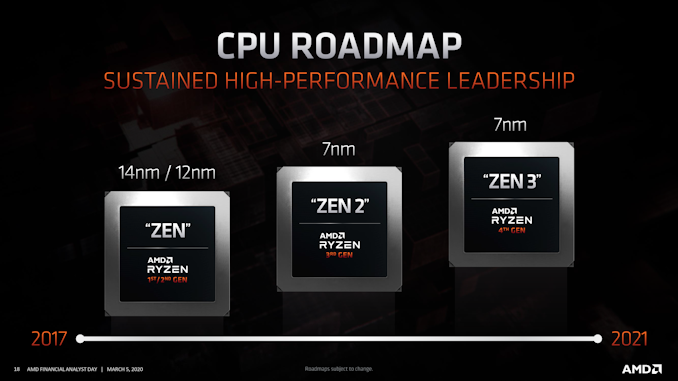AMD Announces Ryzen "Zen 3" and Radeon "RDNA2" Presentations for October: A New Journey Begins
by Ryan Smith on September 9, 2020 5:30 PM EST
AMD today has announced that they will be making a pair of consumer product presentations in October. The chipmaker, who has been fairly quiet since the spring, will be holding events for both their consumer Ryzen CPU and Radeon GPU product segments. Dubbing the events “A New Journey Begins”, the company will be announcing the first products based on their eagerly anticipated Zen 3 CPU architecture and RDNA 2 GPU architecture.
Leading the charge will be AMD’s CPU division. On October 8th at noon Eastern, the company will be presenting their Zen 3-based Ryzen desktop processors. AMD’s CEO, Dr. Lisa Su, will be among the presenters.
Following that up just under 3 weeks later will be AMD’s Radeon presentation, which again is at noon Eastern. There the company will be showing off its first products based on the company’s forthcoming RDNA 2 GPU architecture. Meanwhile, tipping their hand a bit early on naming, AMD has confirmed that this will be called the Radeon RX 6000 series.
Next Generation Ryzen Desktop Processors – 10/8, 12 p.m. ET
We are incredibly excited to invite you to learn more about the next wave of Ryzen desktop processors with “Zen 3” architecture, taking our PC gaming and content creation leadership to new heights. Dr. Lisa Su and other AMD senior executives will kick-off this new journey for “Zen 3” and AMD Ryzen at 12 p.m. ET, October 8th.
Next Generation Radeon Graphics – 10/28, 12 p.m. ET
Preparing to delight gamers globally with the next horizon of Radeon Graphics, we invite you to learn more about our RDNA 2 architecture, Radeon RX 6000 series graphics cards, and our deep collaboration with game developers and ecosystem partners who will help us bring the best of Radeon to gamers. Tune in for the reveal of the future of Radeon PC gaming at 12 p.m. ET, October 28th.
AMD hasn’t disclosed any other details about these events at this time, but over the last several months the manufacturer has shared bits and pieces of information relating to its upcoming chip architectures. Based on AMD’s roadmaps, Ryzen Zen 3 processors will be built on an improved version of TSMC’s 7nm process, most likely TSMC’s N7P process given AMD’s comments clarifying that they aren’t committing to EUV for 7nm. Otherwise, for the moment AMD is remaining tight-lipped on the Zen 3 architecture itself, though given that AMD isn’t going to get the benefits of a full node shrink, we’re expecting Zen 3 to deliver some interesting and meaningful architectural improvements over Zen 2.
Meanwhile on the graphics front, AMD and partners have previously confirmed that RDNA 2 will be a DirectX 12 Ultimate (feature level 12_2) compliant GPU architecture, meaning that AMD will be making significant changes to the graphics side of their GPU designs. The Navi 2x family of GPUs will gain support for ray tracing, variable rate shading, and other features that will put AMD’s new GPUs at parity with the competition, both for consoles and PCs. Meanwhile from a performance standpoint, AMD is aiming for a hefty 50% jump in performance-per-watt, which could potentially eliminate the efficiency gap with NVIDIA. As well, the company has previously promised a high-end "top-of-stack" GPU for 4K gaming, so we're expecting some ambitious performance goals from AMD.
Be sure to check in on October 8th and October 28th for more details on AMD’s next generation of consumer parts!
It’s going to be an exciting fall for gamers... time to start a new journey with @AMDRyzen Zen3 and @Radeon RDNA2 pic.twitter.com/O9SXvLo4y0
— Lisa Su (@LisaSu) September 9, 2020
Source: AMD












143 Comments
View All Comments
Cellar Door - Wednesday, September 9, 2020 - link
Initial stock will be vapour and at inflated prices, 2nd batch for Christmas also at inflated prices. Realistic availability in February 2021 @ msrp.Throw in driver possible issues...
AMD dropping the ball, yet again.
mazz7 - Wednesday, September 9, 2020 - link
Who are you? fortune teller??Kigerone - Thursday, September 10, 2020 - link
inflated prices? ProbablyRealistic availability 2021? Nvidia yes, AMD no
Driver issues? For AMD? It's definitely possible
Dropping the ball? 🤔 Not sure where you're getting that from.
nandnandnand - Thursday, September 10, 2020 - link
Nvidia could have worse availability problems. Bad yields at Samsung. Nvidia can also have "possible driver issues".dotjaz - Saturday, September 12, 2020 - link
NVIDIA can have noticeable driver issues. AMD have those on a daily basis.Qasar - Saturday, September 12, 2020 - link
tell that to my 7970 which has been running fine since day one :-) even the phenom X4 is still running along with no issues.Spunjji - Tuesday, September 15, 2020 - link
They never have evidence.Santoval - Sunday, September 13, 2020 - link
To my knowledge it is Samsung's 7nm node that has poor yields, which is probably why it was not chosen by Nvidia. Their (standard) 8nm node is just a souped up slightly denser 10nm node, which Samsung have long experience with so I don't see why there would be yield issues. The 8nm variant they fab Ampere with is probably not standard 8nm but 10nm optimized for high power GPUs.I heard Ampere has a transistor density in the 50 to 55 million transistors per mm^2 (MTr/mm^2) range. Samsung's (mobile oriented) 10nm node has a transistor density of 52 MTr/mm^2, so the densities match. Samsung's mobile oriented 8nm has a transistor density of 61 MTr/mm^2. That's less than 2/3 the transistor density of their 7nm node (for mobile), which is 95 MTr/mm^2, while Ampere's 8nm variant is almost half as dense.
Transistor density is the primary factor of low yields at fabs, therefore I strongly doubt the 8nm variant of Ampere has a yield issue. Capacity, on the other hand, is another matter. Can Samsung fulfill the demand for Ampere? Judging from its reasonable price and spectacular performance increase over Turing I kind of doubt that.
Santoval - Sunday, September 13, 2020 - link
edit about that "Transistor density is the primary factor of low yields at fabs" bit :The No1 factor that affects yields at fabs is arguably die size. Transistor density should be secondary to that (provided it is not unreasonably high).
Spunjji - Tuesday, September 15, 2020 - link
Wasn't Samsung's 10nm node fairly underwhelming, though? I seem to recall SoCs based on it being more dense than the previous node, but without any improvements in power characteristics. That would explain why Nvidia are having to push Ampere past the edge of its voltage shoulder to get the performance they want (which is usually AMD's thing to do when they're playing catch-up).